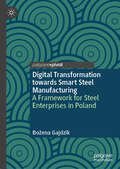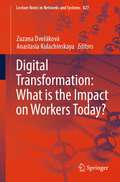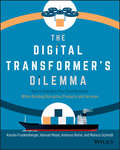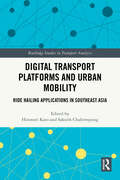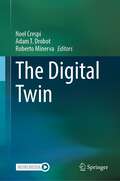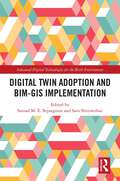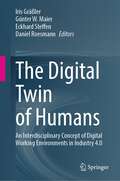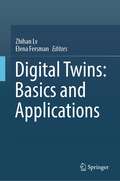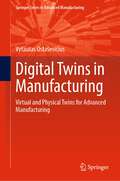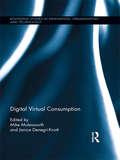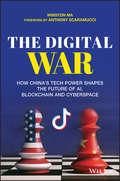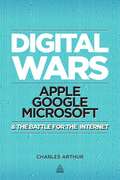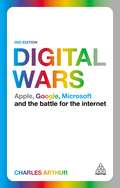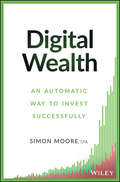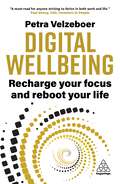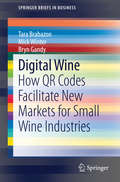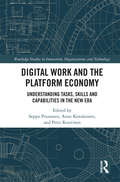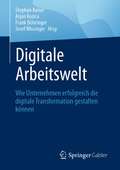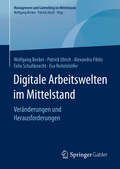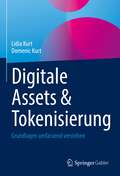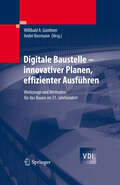- Table View
- List View
Digital Transformation towards Smart Steel Manufacturing: A Framework for Steel Enterprises in Poland
by Bożena GajdzikThis book presents the impact of digital transformation and other megatrends on the steel industry, focusing on the digitization of processes, and the automation and robotization of operations in steel companies. Technological innovations in the steel industry are presented, as well as the changes taking place within the supply chains An essential part of the book is the results of direct research, which deal with the transformation of enterprises to smart steel manufacturing. The research was done on the Polish steel market, which is an open market with foreign capital. Exploring a sample of representatives of steel companies that serve both domestic and foreign markets, this book discusses the implementation of the pillars of Industry 4.0 as well as the strategic transformation of the steel industry.
Digital Transformation: What is the Company of Today? (Lecture Notes in Networks and Systems #805)
by Andrea Bencsik Anastasia KulachinskayaThis book offers the latest research on organizational management, knowledge management, organizational functioning, organizational digitalization, and other issues of modern company development. The book proposes to look at the pool of these problems through the prism of building various models for implementing digital transformation of business and processes. This book is intended for both young and experienced scientists who want to get acquainted with latest trends and data to use them in their research.
Digital Transformation: What is the Impact on Workers Today? (Lecture Notes in Networks and Systems #827)
by Zuzana Dvořáková Anastasia KulachinskayaThis book offers the latest research on formation of modern workers in the context of digitalization: from constant improvement of new training technologies to growing requirements for employees in workplace, as well as an assessment of specialists' digital skills and dynamics of changes over the past years. The book proposes to look at the pool of these problems through the prism of acquisition of new digital competencies and requirements for a modern worker. This book is intended for both young and experienced scientists who want to get acquainted with latest trends and data to use them in their research.
The Digital Transformer's Dilemma: How to Energize Your Core Business While Building Disruptive Products and Services
by Karolin Frankenberger Hannah Mayer Andreas Reiter Markus SchmidtBring your company into the digital era without compromising your core business In The Digital Transformer's Dilemma: How to Energize Your Core Business While Building Disruptive Products and Services, the authors show companies how to go digital while also advancing their core business. The book emphasizes how to strike a difficult balance between establishing a new (digital) business and re-vitalizing – and digitizing – the legacy business. The core of the book is focused on the actual implementation of the digital transformation across both businesses, providing concrete tips, tricks, tools and action plans across six key dimensions: Crafting a flexible organization Using technology as a driver Designing the necessary processes Building transformational leaders “Right-skilling” the workforce of the future Galvanizing cultural change The Digital Transformer’s Dilemma is a very visual book, filled with dozens of engaging illustrations that bring the contained concepts to life on the page. Based on 100+ interviews with senior executives at leading companies (such as Nestlé, Novartis, Volkswagen, BNP Paribas, BASF and Michelin) and smaller hidden champions, numerous illuminating case studies, and the authors’ own experience from working in international management consulting and years of academic experience, the book highlights the fundamental principles required for executives and businesspeople to transform legacy organizations into digitally empowered companies.
Digital Transitioning in the Built Environment of Developing Countries
by Innocent Musonda Adetayo Onososen Thembani MoyoThis book serves as a helpful guide for anyone interested in understanding and implementing Building Information Modelling (BIM) in developing countries. It focuses on the construction industry and how digital technologies can improve the way buildings and infrastructure projects are planned, designed, and built. The book starts by explaining what BIM is and why it's important. It then explores the challenges that developing countries face when adopting BIM, such as limited resources and lack of infrastructure. The authors provide practical solutions to overcome these challenges based on real-world examples and case studies. The book takes readers through a step-by-step process to create a roadmap for BIM adoption. It helps readers understand the necessary steps and strategies involved, such as setting clear goals, involving all relevant stakeholders, and managing changes in the way things are done.One of the book's unique features is that it focuses specifically on the needs and circumstances of developing countries. It recognises that these countries have different challenges compared to more developed nations. By addressing these specific challenges, the book provides tailored advice that readers can apply in their own contexts. The book also emphasises the need for training and capacity building. It acknowledges that many professionals in developing countries may not have the necessary skills and knowledge to fully utilise BIM. Therefore, it introduces an approach called the dynamic capacity model, which helps ensure that people receive the training they need to successfully implement BIM. Overall, this book is a practical and accessible resource for anyone interested in implementing BIM in the construction industry of a developing country. It is important reading for professionals and academics in construction management, engineering, architecture, infrastructure development, urban planning, and governance in developing nations.
Digital Transport Platforms and Urban Mobility: Ride Hailing Applications in Southeast Asia (Routledge Studies in Transport Analysis)
by Hironori Kato Saksith ChalermpongThis book offers comprehensive state-of-the-art knowledge of how ride-hailing applications (RHAs) are changing the landscape of urban mobility in developing Southeast Asia by examining the disruptions they cause, the impacts of RHAs on the transportation system, and public policy responses aimed at mitigating these impacts.Providing new perspectives on the familiar issues by taking the local contexts of middle-income SEA into account, where abundant and diverse modes of informal transportation thrive amidst rapid urbanization and motorization, the book also draws lessons based on empirical evidence on how public interventions can benefit urban mobility for other developing countries. Each city-specific chapter sets the stage by overviewing the city and its transportation system, and delves into the specifics of its RHA market, such as market structure and demand characteristics. Impacts of RHAs on other transportation operators as well as responses from affected parties are discussed, followed by the ensuing regulatory efforts and their outcomes. Findings from each city are internationally compared and lessons drawn from them that are useful for policymaking. The book will present insights into useful and effective policy interventions pertaining to RHAs, including how the new technology may affect the infrastructure investment decision and how RHA may be leveraged as an intervention tool in urban mobility in developing countries.Digital Transport Platforms and Urban Mobility provides academics and upper level students with in-depth knowledge and practices of the disruptive technology in urban transportation due to the advent of mobile ride-hailing applications in Southeast Asian countries. It will be an invaluable resource for all those interested in transportation planning and policy, urban and regional planning, with a particular emphasis on sustainability.
The Digital Twin
by Noel Crespi Adam T. Drobot Roberto MinervaThe Digital Twin is crucial and timely for positively affecting how we work, live, and play. It eliminates the gap between experimentation and learning by bridging real and virtual worlds in a powerful methodology, making significant headway in conquering previously unsolvable problems and challenges. Digital Twins are made possible by four widely deployed infrastructures for connectivity, computing, digital storage, and sources of digital data. The Digital Twin provides insights, paths to innovation, efficient production of goods, improved delivery of services, better experiences and entertainment, and new business models. Investing in Digital Twins is one of the most valuable ways to create sustainable paths to the future. The Digital Twin book is the most comprehensive work on the subject to date. It brings together top practitioners, technical experts, analysts, and academics to explore and discuss the concept of the Digital Twin, its history, evolution, and the profound impact across sectors of the global economy. The book addresses the business value, technological underpinnings, lessons learned from implementations, resources for success, practical approaches for implementation, and illustrative use cases. It makes the case for why we believe that Digital Twins will fundamentally transform major industries and enable us to fulfill important societal goals. The book is recommended for key decision makers, senior executives, technical leaders, researchers, and students.
Digital Twin Adoption and BIM-GIS Implementation (Advanced Digital Technologies for the Built Environment)
by Sepasgozar, Samad M. E. Sara ShirowzhanThe aim of this edited book volume is to present new concepts, and applications of Digital Twin and relevant tools in the built environment context. The book identifies key organisational factors that influence the adoption of technology within the architectural service industry, setting the stage for a deeper understanding of the shift towards digital methodologies.The book introduces the Digital Twin Readiness Level framework, a modified metric system with ten levels of risk‑based maturity and an empirical development of a Digital Twin Adoption Model. Furthermore, the text ventures into immersive virtual environments and their applications, showcasing innovative practices that enhance learning and operational efficiency.Additionally, the book examines the integration of Building Information Modelling (BIM) and Geographic Information Systems (GIS), revealing new workflows for creating 3D models of cities. A focus on Australia’s government‑funded infrastructure projects offers insights into the values and acceptance criteria for these technologies, providing a comprehensive overview of their practical implications and future potential. This book is essential reading for practitioners, engineers, and managers involved in any phase of the built environment from design to operation and other architectural, engineering, and construction (AEC) stakeholders who are a part of digital transformations, as well as researchers, educators, and students interested in the field.
The Digital Twin of Humans: An Interdisciplinary Concept of Digital Working Environments in Industry 4.0
by Iris Gräßler Günter W. Maier Eckhard Steffen Daniel RoesmannThis book provides an interdisciplinary concept of digital working environments in industry 4.0 to enable the implementation of the digital twin of humans.Information and communication technology is penetrating all areas of daily life at a rapid pace in private and professional areas. These technologies enable companies to aggregate huge volumes of data. Collected personal data of employees creates the opportunity of a digital representation of the human being itself, that is conformant with the definition of a digital twin. These digital twins of humans include selected characteristics and behaviour of the humans, that are linked to models, information, and data. According to existing trend studies, the digital twin of humans is a technology that will have a significant impact on the economy, society, and people. It is important to consider the regulatory framework for the use of personal data and threats of misuse.This book will be of use to researchers and professionals in industry.
Digital Twins: Basics and Applications
by Zhihan Lv Elena FersmanThis book comprehensively introduces readers to Digital Twins, from the basic concepts, core technologies and technical architecture, to application scenarios and other aspects. Readers will gain a profound understanding of the emerging discipline of Digital Twins. Covering the latest and cutting-edge application technologies of Digital Twins in various fields, the book offers practitioners concrete problem-solving strategies. At the same time, it helps those working in Digital Twins-related fields to deepen their understanding of the industry and enhance their professional knowledge and skills. Given its scope, the book can also be used as teaching material or a reference book for teachers and students of product design, industrial design, design management, design marketing and related disciplines at colleges and universities. Covering a variety of groundbreaking Digital Twins technologies, it can also provide new directions for researchers.
Digital Twins in Manufacturing: Virtual and Physical Twins for Advanced Manufacturing (Springer Series in Advanced Manufacturing)
by Vytautas OstaševičiusThis book presents a guide to digital twin technologies and their applications within manufacturing. It examines key technological advances in the area of Industry 4.0, including numerical and experimental models and the Internet of Things (IoT), and explores their potential technical benefits through real-world application examples. This book presents digital models of advanced manufacturing processes dynamics that enable to control the cutting processes including experimental and simulation studies for brittle-ductile transition of ultra-precision machining materials assuring product quality. Innovative electrical power harvesting solutions from tool vibrations and wireless data transmission from confined and heavily cooled environment are also included. It explains the benefits of virtual and physical twins adapted to real systems, including the ability to shorten the product's path to the market, and enabling the transition to higher value-added manufacturing processes. Including numerous illustrations and clear solved problems, this book will be of interest to researchers and industry professionals in the fields of mechatronics, manufacturing engineering, computational mechanics.
Digital Virtual Consumption (Routledge Studies in Innovation, Organizations and Technology)
by Janice Denegri-Knott Mike MolesworthDigital media present opportunities for new types of consumption including desiring, buying, collecting, making, and even selling digital virtual goods. To these activities we can add those taking place in virtual communities of consumption, online shops, brand websites, and online auction houses that together amount to a vast new landscape of consumption. Digital virtual consumption motivates concatenated practices which produce meaningful experience for their users as well as market opportunities to profit from them. Consumers create and maintain elaborate wish lists, engaging with simulations of brands on websites and in videogames, coveting items for use in online games and even spending ‘real’ money on these, undertaking entrepreneurial activity in virtual worlds, conjuring nostalgia via online auctions, engaging in playful consumption in other new retail formats, writing reviews of products as part of the consumption experience, engaging in online activist activities, and many other emerging behaviors. Analyses of consumption in the digital virtual realm are however limited. This collection brings together experienced researchers from the fields of consumer research, digital games, and virtual worlds to provide conceptual and empirical work that helps us understand these new and significant consumer activities. Online communities negotiate the ‘correct’ use of goods and offer technical advice, consumers develop new products, individuals create and distribute their own promotional material for their favorite brands, and entrepreneurial consumers marketing and selling their own products online. Here we may see a blurring of consumption and production, or work and leisure activity that requires further thought about what makes it meaningful for individuals. The chapters in this volume take stock of the emergence and likely importance of digital virtual consumption for consumer culture, including a review of both new and existing conceptual and methodological tools as well as a resource of key examples and analyses of practices.
The Digital War: How China's Tech Power Shapes the Future of AI, Blockchain and Cyberspace
by Winston MaWhat new directions in China’s digital economy mean for us all China is the largest homogenous digital market on Earth: unified by language, culture, and mobile payments. Not only a consumer market of unrivaled size, it’s also a vast and hyperactive innovation ecosystem for new technologies. And as China’s digital economy moves from a consumer-focused phase to an enterprise-oriented one, Chinese companies are rushing to capitalize on ways the newer wave of tech—the Internet of Things, AI, blockchain, cloud computing, and data analytics (iABCD)—can unlock value for their businesses from non-traditional angles. In China’s Data Economy, Winston Ma—investment professional, capital markets attorney, adjunct professor of digital economy, and bestselling author—details the profound global implications of this new direction, including how Chinese apps for services such as food delivery expand so quickly they surpass their U.S. models within a couple of years, and how the sheer scale and pace of Chinese innovation might lead to an AI arms race in which China and the U.S. vie aggressively for leadership. How China’s younger netizens participate in their evolving digital economy as consumers, creators, and entrepreneurs Why Online/Office (OMO, Online-merge-with-Offline) integration is viewed as the natural next step on from the O2O (Online-to-Offline) model used in the rest of the world The ways in which traditional Chinese industries such as retail, banking, and insurance are innovating to stay in the game What emerging markets can learn from China as they leapfrog past the personal computer age altogether, diving straight into the mobile-first economy Anyone interested in what’s nex
Digital Wars
by Charles ArthurApple, Google and Microsoft are locked in a battle to dominate the internet and especially the fastest-growing part of it - mobile. All three have fought each other in previous wars, and now they want to dominate search technology, cloud computing, mobile music and the smartphone market. Whoever wins will exert a wide ranging control over user data and access to content, and even how we use and interact with computers. Digital Wars assesses who will be the victor and what the implications are for business, individuals and society. Accessible and comprehensive, it looks at the very different cultures of each business, the iPhone, Android, iPods (mobile music) and the browser and apps battles. Digital Wars tells you what to expect from the internet in the next five years, which company will ultimately be in the driving seat, and what the implications will be for us all.
Digital Wars: Apple, Google, Microsoft and the Battle for the Internet
by Charles ArthurThe first time that Apple, Google and Microsoft found themselves sharing the same digital space was 1998. They were radically different companies and they would subsequently fight a series of pitched battles for control of different parts of the digital landscape. They could not know of the battles to come. But they would be world-changing.<P> This new edition of Digital Wars looks at each of these battles in turn. Accessible and comprehensive, it analyzes the very different cultures of the three companies and assesses exactly who are the victors on each front. Thoroughly updated to include information on the latest developments and rising competitors Samsung, it also include a completely new chapter on how China moved from being the assembly plant for music players and smartphones, to becoming the world's biggest smartphone business.
Digital Wealth
by Simon MooreLeverage algorithms to take your investment approach to the next level Digital Wealth: An Automatic Way to Invest Successfully reveals core investment strategies that you can leverage to build long-term wealth. More than a simple review of traditional investment strategies, this innovative text proffers digital investment techniques that are driven not by people but by algorithms. Supported by asset allocation research, the secrets shared in this forward-thinking book have underpinned cutting-edge investment firms as they integrate algorithm-based strategies. In addition to presenting key concepts, this groundbreaking resource explains how these concepts can give you an edge over the professionals on Wall Street through details regarding achieving financial security and meeting financial goals rooted in a firm foundation in behavioral finance, portfolio tilts, and modern portfolio theory. Investment strategies have evolved from one generation to the next, and the ability to leverage new digital tools calls for another overhaul of traditional investment concepts. Investment techniques implemented by algorithm rather than by human monitoring can, in some cases, prove more successful. The key to a balanced portfolio is understanding what these algorithm-based strategies are, and how to best use them. Explore insights from multiple Nobel Prize winning academics that can give your investment strategy an edge Consider how technology can open up powerful techniques to mainstream investors, including tax-loss harvesting and automated rebalancing Discuss how cost minimization and a strategic tax approach can boost your portfolio's compound growth Identify strategies that support the long-term growth of your wealth Digital Wealth: An Automatic Way to Invest Successfully is an essential text for sophisticated individual investors and investment consultants alike who want to explore how digital tools can bolster financial success.
Digital Wellbeing: Recharge Your Focus and Reboot Your Life
by Petra VelzeboerDigital detoxes don't work. Our wellbeing relies on finding a balance. Improve your focus and create healthy habits that will enrich your life with Digital Wellbeing.So much of our lives are now spent looking at screens, whether we're working on our laptop or checking social media on our phones. It's too easy to become overwhelmed by constant notifications and endless emails, leading to frustration, stress and burnout.In this groundbreaking book, leading wellbeing expert Petra Velzeboer draws upon academic research and fascinating interviews with global experts to uncover the practical insights that will allow you to improve your daily life, set healthy boundaries with technology and prioritize your Digital Wellbeing.
Digital Wine
by Tara Brabazon Mick Winter Bryn GandyThis book explores the way in which QR codes (Quick Response codes) can help the wine industry facilitate distribution and more effectively market and sell their product. It examines the interventions, invention and opportunities brought about by QR codes for the wine industry. It also investigates how QR codes can help enable regional development as well as information and knowledge about winemakers and regions. The book begins with an introduction to QR codes. It explains how to use them as well as shows how QR codes combine analogue and online promotion and information dissemination. Next, the book explores strategies and examples from the creative industries, small nation theory and emerging wine industries. It then goes on to examine how to integrate QR codes with wine media, including marketing the bottle and using QR codes to build new wine regions. The book concludes with a case study of how Aotearoa/New Zealand wine producers deploy QR codes. QR codes can store and digitally present, a range of helpful data, including URL links, geo-coordinates and text and can be scanned by smart phones, making them a useful marketing and business tool. Presenting detail research on how QR codes can enhance the relationship between producers and consumers as well as aid regional development in the wine industry, this book will be of interest to academics focusing on Wine Studies, small and medium sized enterprises (SMEs) and practitioners and researchers from the creative industries sector. In addition, while this book focuses on the wine industry, the information that it presents about QR codes is relevant and applicable for an array of industries that require a tether between analogue and digital, physical and virtual, especially food and primary production.
Digital Work and the Platform Economy: Understanding Tasks, Skills and Capabilities in the New Era (Routledge Studies in Innovation, Organizations and Technology)
"Uberization," "digitalization," "platform economy," "gig economy," and "sharing economy" are some of the buzzwords that characterize the current intense discussions about the development of the economy and work around the world, among both experts and laypersons. Immense changes in the ways goods are manufactured, business is done, work tasks are performed, education is accomplished, and so on, are clearly underway. This also means that demand for careful, first-rate social scientific analyses of the phenomena in question is rapidly growing. This edited volume gathers distinguished researchers from economics, business studies, organization studies, medicine, social psychology, occupational health, pedagogics, and sociology to put particular work in both public and private sectors and education in both academic and vocational settings at the focus of the emerging digitalized platform economy. The authors anchor their analyses and conceptual and theoretical work in distinctive empirical developments that are taking place in one of the leading countries of digitalization processes: Finland. Finnish case studies reflect general global developments and show their particular, context-related actualization in multiple ways. This double exposure enables the authors of this multi- and interdisciplinary volume to advance conceptualization and theorization of the key phenomena in digitalizing platform societies in novel, creative, and groundbreaking directions. This book will without doubt be of great value to academic researchers and students in the fields of economics, business studies, work studies, social sciences, education, technology, digitalization, platforms, occupational health, entrepreneurship, and professions.
Digital Work in the Planetary Market (International Development Research Centre)
by Mark Graham and Fabian FerrariUnderstanding the embedded and disembedded, material and immaterial, territorialized and deterritorialized natures of digital work. Many jobs today can be done from anywhere. Digital technology and widespread internet connectivity allow almost anyone, anywhere, to connect to anyone else to communicate and exchange files, data, video, and audio. In other words, work can be deterritorialized at a planetary scale. This book examines the implications for both work and workers when work is commodified and traded beyond local labor markets. Going beyond the usual &“world is flat&” globalization discourse, contributors look at both the transformation of work itself and the wider systems, networks, and processes that enable digital work in a planetary market, offering both empirical and theoretical perspectives. The contributors—leading scholars and experts from a range of disciplines—touch on a variety of issues, including content moderation, autonomous vehicles, and voice assistants. They first look at the new experience of work, finding that, despite its planetary connections, labor remains geographically sticky and embedded in distinct contexts. They go on to consider how planetary networks of work can be mapped and problematized, discuss the productive multiplicity and interdisciplinarity of thinking about digital work and its networks, and, finally, imagine how planetary work could be regulated. Contributors Sana Ahmad, Payal Arora, Janine Berg, Antonio A. Casilli, Julie Chen, Christina Colclough, Fabian Ferrari, Mark Graham, Andreas Hackl, Matthew Hockenberry, Hannah Johnston, Martin Krzywdzinski, Johan Lindquist, Joana Moll, Brett Neilson, Usha Raman, Jara Rocha, Jathan Sadowski, Florian A. Schmidt, Cheryll Ruth Soriano, Nick Srnicek, James Steinhoff, Jara Rocha, JS Tan, Paola Tubaro, Moira Weigel, Lin Zhang
Digitale Arbeitswelt: Wie Unternehmen erfolgreich die digitale Transformation gestalten können
by Stephan Kaiser Arjan Kozica Frank Böhringer Josef WissingerDer Weg in die digitale Arbeitswelt ist für viele Unternehmen eine herausfordernde und komplexe Veränderung. Um diesen Weg erfolgreich zu beschreiten, benötigen Unternehmen funktionierende Managementinstrumente. Im Projekt „DigiTraIn 4.0: Indiziert. Transformiert. Digitalisiert. Instrumente für den erfolgreichen Wandel ins Arbeiten 4.0“ wurden vier Instrumente für eine gelingende Transformation in das digitale Arbeiten entwickelt und in der Unternehmenspraxis erprobt.In diesem Herausgeberwerk werden die zentralen Projektergebnisse vorgestellt. Die Autorinnen und Autoren führen in die einzelnen Instrumente ein und zeigen anwendungsnah weitere vertiefende Aspekte der digitalen Transformation für die Unternehmenspraxis auf (z. B. Technostress, digitales Mindset, Führung, Homeoffice).
Digitale Arbeitswelten im Mittelstand: Veränderungen und Herausforderungen (Management und Controlling im Mittelstand)
by Wolfgang Becker Patrick Ulrich Alexandra Fibitz Felix Schuhknecht Eva ReitelshöferDigitalisierung, Industrie 4.0, Globalisierung und demografischer Wandel transformieren zunehmend die aktuelle Arbeitswelt. Gerade für den Mittelstand stellt dies trotz seiner hohen Innovationskraft und Flexibilität eine enorme Herausforderung dar. Bisherige Unternehmensstrukturen und –prozesse sowie eine tradierte Strategie und Führungskultur sind in der Regel durch den engen persönlichen Kontakt geprägt und werden durch die digitalen Arbeitswelten auf den Prüfstand gestellt. Anhand aktueller empirischer Daten, die durch die Hochschule Aalen und die Otto-Friedrich-Universität Bamberg erhoben wurden, widmet sich das Buch mit Fokus auf den Mittelstand der Frage nach den Rahmenbedingungen der digitalen Arbeitswelten sowie den Fragestellungen, ob und wie sich die Aufgaben und Kompetenzen von Führungskräften durch die digitalen Arbeitswelten verändern, welche Chancen und Risiken Arbeitszeit- sowie Arbeitsplatzflexibilisierung im Arbeitsalltag bieten und ob und wie mittelständische Unternehmen Diversity-Management- und Change-Management-Maßnahmen einbinden.
Digitale Assets & Tokenisierung: Grundlagen umfassend verstehen
by Lidia Kurt Domenic KurtDieses Fachbuch gibt den Leser*innen einen fundierten Start in das Thema «Digitale Assets und Tokenisierung». Blockchain-Technologien verändern die Finanzwelt drastisch und führten zur Geburt von digitalen Vermögenswerten. Während es inzwischen einen breiten Fundus an Blockchain-Einführungsliteratur gibt, so fehlt ein auf die Finanzindustrie und Vermögenswerte fokussiertes Werk. Das Buch zeigt die Welt der digitalen Vermögenswerte holistisch von mehreren Perspektiven aus. Es vermittelt das relevante technologische Wissen für die Erstellung und Bewirtschaftung eines digitalen Vermögenswertes, es zeigt die zu beachtenden rechtlichen Fragestellungen auf und gibt einen breiten Einblick in die wirtschaftlichen Voraussetzungen, um digitale Vermögenswerte auf dem Markt etablieren zu können. Das Ziel des Fachbuchs ist die praxisnahe und ganzheitliche Vermittlung der relevanten Informationen, um Projekte im Bereich der digitalen Vermögenswerte kritisch evaluieren und erfolgreich umsetzen zu können.
Digitale Baustelle- innovativer Planen, effizienter Ausführen
by André Borrmann Willibald GünthnerDas Konzept der digitalen Baustelle beschreibt die Abbildung aller bei einem Bauvorhaben anfallenden Daten in einem Baustellenmodell. Es bietet die Grundlage für einen durchgängigen Datenfluss und damit für effizientere Planungs- und Ausführungsprozesse. In dem Band stellen Experten aus Wissenschaft und Industrie Methoden und Technologien zur Umsetzung vor, darunter die 3D-gestützte Planung, die Nutzung von Systemen zur zentralen Datenhaltung, die computergestützte Simulation des Bauablaufs und die Einführung moderner Logistikkonzepte.
Digitale Bildung und Künstliche Intelligenz in Deutschland: Nachhaltige Wettbewerbsfähigkeit und Zukunftsagenda (AKAD University Edition)
by Ronny Alexander FürstDieses Buch fokussiert die in der Corona-Pandemie besonders deutlich gewordene Notwendigkeit der digitalen Bildung und Nutzung der KI. Es zeigt dabei, wie digital gebildete Menschen zum Erfolgsgaranten und gesellschaftlichen Stabilisator werden. Ferner diskutiert es, wie Digitale Bildung am wirkungsvollsten angegangen werden kann, welche Herausforderungen bestehen und welche Chancen es jetzt zu nutzen gilt – auch für die Wirtschaft. Die aktuellen Beiträge von namhaften Wissenschaftlern und Praxisvertretern basieren auf dem 11. Wissenschaftsforum der AKAD University und diskutieren neueste Forschungsergebnisse aus unterschiedlichen Fachrichtungen zu vier theoretischen Leitlinien:· Standortbestimmung und Erhaltung der digitalen Wettbewerbsfähigkeit· Antworten der KI auf menschliche Leistungsgrenzen und vice versa· Gesellschaftliche Zukunftsagenda der Digitalen Bildung in Deutschland· Digitalisierung und Hochschulbildung im Kontext Künstlicher Intelligenz „Im Rahmen der Digitalstrategie der Bundesregierung wollen wir digitale Bildung in allen Bildungsbereichen möglich machen. Wir wollen, dass alle Generationen digital kompetent werden. Künstliche Intelligenz (KI) kann dabei unterstützen, Lerninhalte und Aufgaben an individuelle Bedürfnisse, Lernstrategien und Kompetenzen anzupassen.“ Anja Karliczek, aus dem Grußwort der Bundesministerin für Bildung und Forschung„Digitale Bildung bedeutet aber nicht bloß, neue Technologien zu bedienen lernen. Es geht darum, Schülerinnen und Schülern, Auszubildenden und Studierenden umfassende Kompetenzen zu vermitteln und sie gut auf die Anforderungen der Arbeitswelt von morgen vorzubereiten.“Dorothee Bär, aus dem Vorwort der Staatsministerin für Digitales
